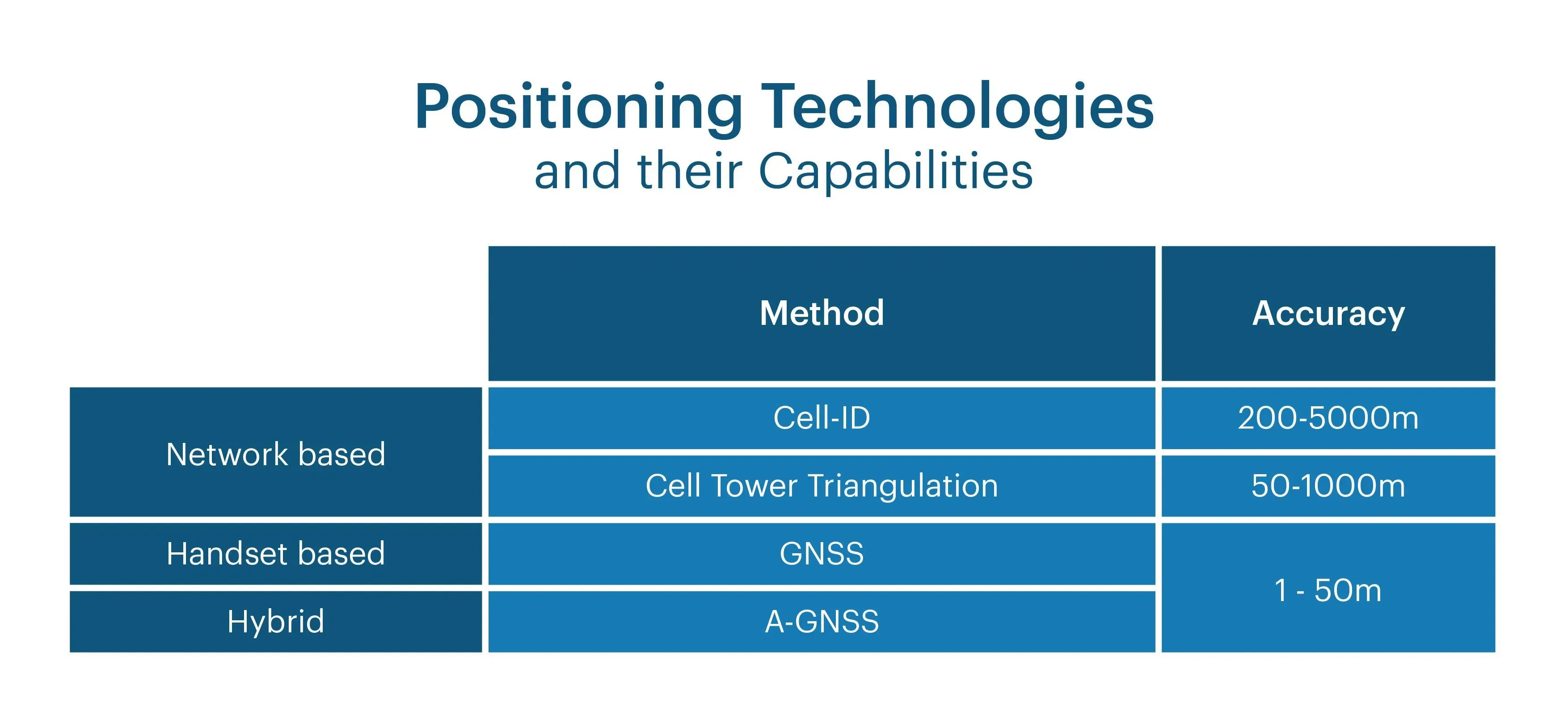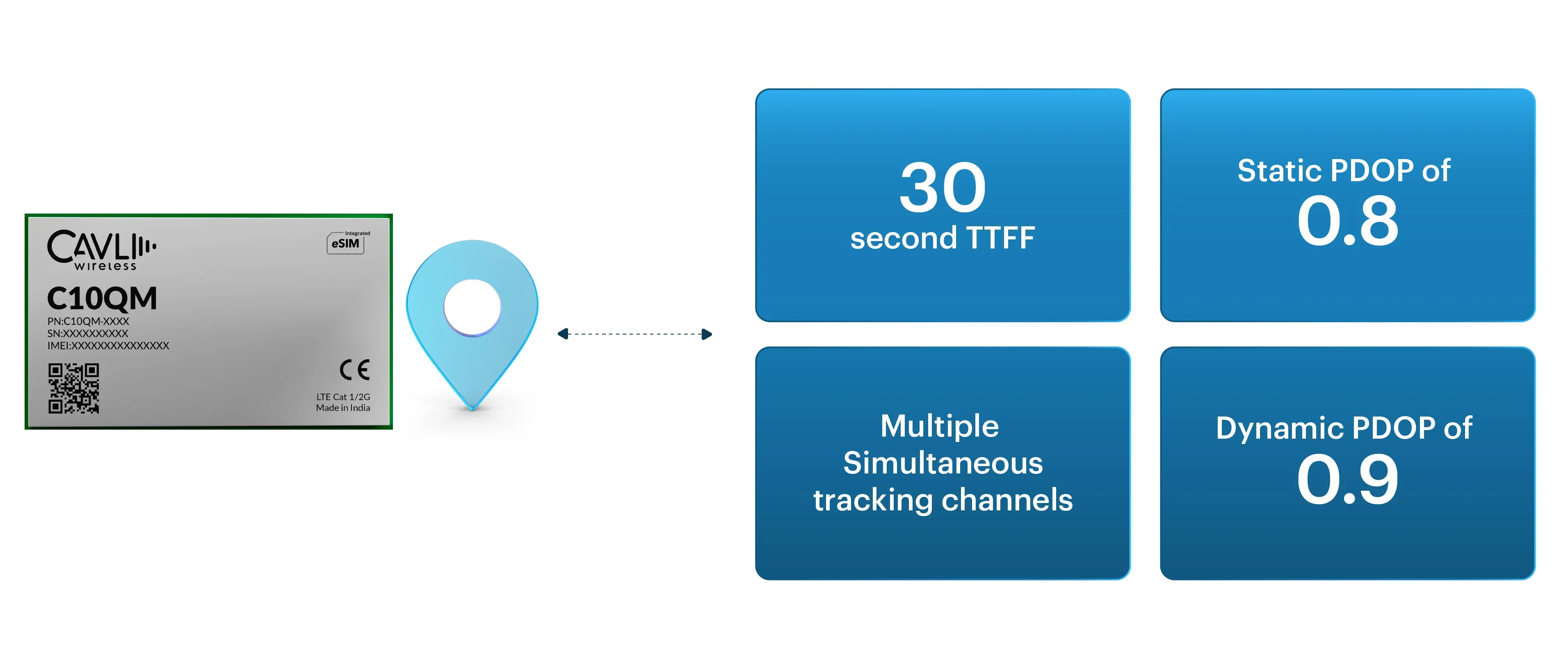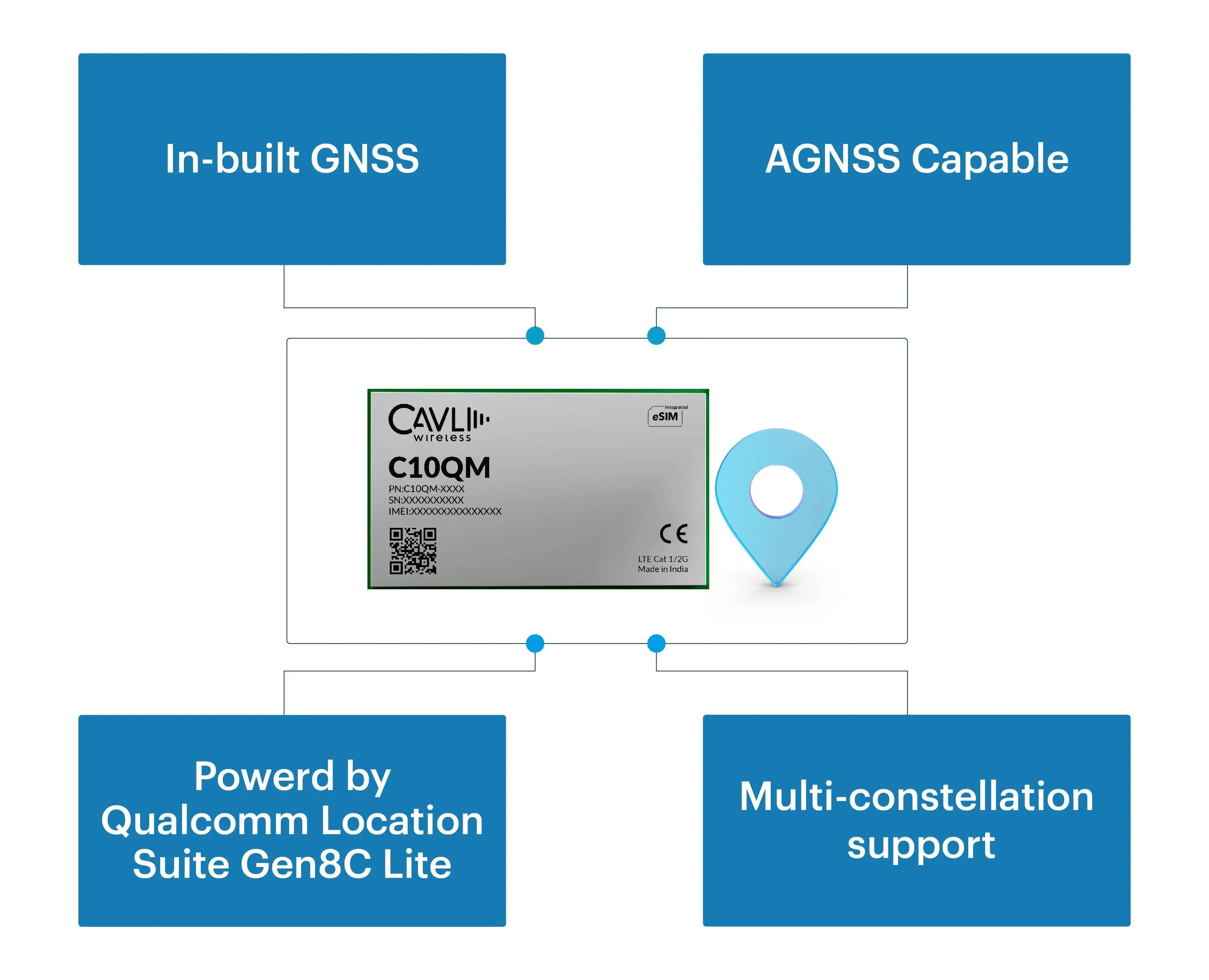The Internet of Things (IoT) landscape is rapidly expanding, with billions of connected devices forecasted to become an integral part of global ecosystems in industries ranging from agriculture to smart cities. One of the most critical aspects of these connected solutions is location tracking and navigation, particularly for applications such as asset tracking, fleet management, and environmental monitoring.
However, the IoT industry faces several challenges when integrating Global Navigation Satellite System (GNSS) solutions into Cellular IoT modules due to variety of factors that include but are not limited to:
Multi-Satellite Support:
The need for global coverage demands compatibility with multiple GNSS constellations such as GPS, GLONASS, Galileo, and BeiDou.
Time-to-First-Fix (TTFF):
For optimal performance, GNSS devices need to determine their location quickly after startup. Delays in this "first fix" can hinder the performance of real-time applications.
AGNSS Capability:
Embedded devices with GNSS usually require greater time for first fix due to the latency introduced by communicating directly with satellites. With AGNSS, the time for fix is reduced greatly while also enhancing accuracy.
Sensitivity and Performance in Challenging Environments:
IoT devices are often deployed in remote or harsh environments where satellite signals can be weak, affecting tracking accuracy and reliability.
Power Consumption:
GNSS modules often consume significant power, which can be detrimental for battery-operated IoT devices.
The Criticality of AGNSS in Embedded Devices
For embedded devices across industries, from asset trackers to smart city infrastructure, knowing "where" is as crucial as knowing "what" as location awareness is no longer a luxury—it's a necessity. But how do these devices pinpoint their location accurately and efficiently? The answer lies in the clever implementation of positioning systems.
Broadly, there are three main categories of positioning systems employed in embedded devices:

1. Network-Based Positioning:
This approach leverages existing cellular infrastructure to estimate location.
Cell-ID: A simple method that identifies the location of the cell tower the device is connected to, providing a rough estimate within a cell's coverage area.
Cell Tower Triangulation: By analyzing signals from multiple cell towers, a more accurate location can be triangulated, although accuracy can vary depending on tower density, signal strength and lay of the land.
2. Hardware-Based Positioning:
This method relies on dedicated hardware within the device to receive signals from Global Navigation Satellite Systems (GNSS) like GPS, GLONASS, Galileo and Beidou.
GNSS: Offers the highest degree of accuracy, often within a few meters, making it suitable for applications demanding precise location data. However, acquiring a satellite fix (TTFF - Time-To-First-Fix) can take time depending upon the hardware utilized alongwith factors such as how many satellites are in view.
3. Hybrid Positioning:
This approach combines the best of both worlds, leveraging the strengths of both network and satellite-based methods.
Assisted GNSS (AGNSS): Significantly accelerates the TTFF by using cellular networks to provide assistance data to the GNSS receiver. This data, often containing information about satellite positions and timing, helps the device acquire a satellite fix much faster, typically within 20 seconds, and in ideal conditions with strong network signals and a robust AGNSS server, it can even reach sub-10 second TTFF values.
Enter the Cavli C10QM, a GNSS-enabled cellular IoT module that is based on LTE Cat 1 network and has been designed with features to tackle the above mentioned hurdles.
The Cavli C10QM: Tackling GNSS Challenges
The C10QM is an IoT module designed for connectivity solutions across industries, with a focus on reliable GNSS performance. As part of Cavli Wireless’ C-series, the C10QM integrates GNSS and Assisted GNSS (AGNSS) to offer rapid, accurate positioning while addressing some of the critical hurdles faced by IoT solution developers today.
Key to the C10QM’s effectiveness is its multi-satellite system compatibility, which supports GPS, GLONASS, Galileo, and BeiDou. This increases its availability in both urban and rural environments, where satellite visibility may vary. By supporting multiple constellations and incorporating AGNSS for quicker location fixes, the module offers a robust solution for IoT applications.
Multi-Constellation Support:
The C10QM provides global coverage by supporting four GNSS constellations: GPS, GLONASS, Galileo, and BeiDou. This ensures a stronger satellite signal lock and improves positional accuracy, especially in urban environments where tall buildings might obstruct satellite signals.
Fast Time-to-First-Fix (TTFF):
The performance data provided shows promising GNSS fix times. For outdoor static cold starts, the C10QM delivers swift TTFF, ensuring that the module can determine its location quickly after powering up. This is critical for applications such as tracking assets that may move between covered and uncovered areas.
Assisted GNSS (AGNSS) Capable:
AGNSS enhances the module’s capability by allowing it to use network data stored in an AGNSS server to expedite satellite acquisition.
Learn more about GNSS in general and AGNSS by reading our earlier blog on the topic: Choosing between Integrated & In-built GNSS to Elevate your Connected Solutions
Network-Based Advantages:
Speed:
C10QM's AGNSS leverages the immediacy of cellular networks. By delivering assistance data to the GNSS receiver, it drastically reduces the time-consuming process of satellite acquisition, resulting in significantly faster Time-To-First-Fix (TTFF) compared to standalone GNSS.
Indoor and Urban Performance:
Network-based positioning methods excel in environments where satellite signals are weak or obstructed, such as indoor locations or dense urban areas. The C10QM can leverage cell tower signals to provide a location estimate even when a clear sky view is unavailable, ensuring a more consistent and reliable performance.
Hardware-Based Advantages:
Accuracy:
C10QM's AGNSS ultimately relies on the precise timing and ranging capabilities of GNSS signals. While it uses the network to expedite the initial fix, the final location determination benefits from the inherent accuracy of satellite-based positioning.
Global Coverage:
GNSS constellations offer global coverage, making it possible to determine location virtually anywhere on Earth. C10QM inherits this advantage, ensuring seamless operation across geographical boundaries without hiccups.
Superior Sensitivity:
According to our internal tests, the C10QM features tracking sensitivity of up to -158 dBm and reacquisition sensitivity of -156 dBm, allowing the module to operate efficiently even in low-signal environments. This makes it ideal for IoT deployments in remote areas, forests, or urban canyons where satellite signals are harder to acquire.
Optimized Power Consumption:
One of the primary challenges of GNSS integration in IoT modules is power consumption. The C10QM incorporates power-saving modes that minimize energy use during periods of inactivity, making it suitable for battery-powered IoT devices that require extended lifetimes in the field.
Engineering Implications for IoT OEMs
Imagine a engineer for a logistics company, seeking to optimize its refrigerated trucking fleet responsible for transporting temperature-sensitive goods like pharmaceuticals. Delays not only impact delivery schedules but could also compromise the integrity of critical medication. Real-time visibility and precise location data are paramount. This is where Cavli's C10QM module, with its advanced GNSS capabilities, demonstrates its true value.
According to our recent tests, the C10QM averaged a remarkable 30-second Time-To-First-Fix (TTFF), a significant leap from the industry average observed in similar conditions. This rapid location acquisition allows for the development of tracking solutions where every second counts. As far as the logistics engineer is concerned, this translates to real-time monitoring of these sensitive assets, enabling proactive route adjustments to avoid congestion, predict arrival times accurately, and ensure the timely delivery of critical medications.

Now the same scenario when AGNSS is supported by the local network provider, TTFF can be brought down to sub 20 seconds, possibly even less than 10 seconds. The variability in time is only dependant on AGNSS server capabilties offered by the operator and network parameters.
Moreover, the C10QM's ability to track multiple satellites simultaneously ensures robust and continuous connectivity, even as the trucks traverse areas with obstructed views of the sky, like tunnels, forrests or dense urban areas. This ensures uninterrupted location data, providing logistics managers with a precise and reliable view of their fleet's movements throughout the entire delivery route. Furthermore, achieving a low static Position Dilution of Precision (PDOP) of 0.8 during real-world testing highlights the module's superior positional accuracy. All these capabilities ensure that the C10QM presents itself as a no-brainer & optimal solution to the engineer intending to upgrade the fleet operations.
Benefits for End Users
Picture a bustling metropolis wherein a company operates fleet of autonomous delivery robots/drones to navigate sidewalks and crosswalks, efficiently delivering goods to residents and businesses. In this intricate urban environment, accurate location tracking, consistent connectivity, and power efficiency are paramount for success. Cavli's C10QM module, with its robust GNSS capabilities, provides the foundation for a new era of reliable smart delivery services. Real-world trials reveal that the C10QM consistently achieves an average Time-To-First-Fix (TTFF) of 140 seconds, even amidst the urban canyons and signal reflections common in dense cityscapes. This rapid and reliable location acquisition ensures that delivery robots can accurately navigate complex routes, avoid obstacles, and arrive at their destinations on time.

For time-critical applications, AGNSS is a game-changer. Consider that the delivery is medicine for an patient in distress. Every second counts, and waiting over a minute for an initial location fix is unacceptable as these seconds lost may define survivability of the patient. AGNSS, by dramatically reducing the TTFF, empowers these devices to provide near-instantaneous location data to emergency responders, enabling faster response times and potentially saving lives.
Furthermore, the module maintains a low dynamic Position Dilution of Precision (PDOP) of 0.9 in these challenging environments, demonstrating its high positional accuracy. This precision is crucial for safe and efficient navigation, allowing the robots to identify designated pick-up and drop-off points with meter-level accuracy, even in crowded areas with limited sidewalk space. Power efficiency is critical for maximizing the robots' operational range and minimizing downtime. The C10QM’s remarkable sensitivity enables it to maintain a reliable GPS fix even in areas with obstructed views of the sky, such as narrow alleys or areas with dense tree cover, reducing the need for frequent, power-consuming searches for satellite signals. Finally, the C10QM's multi-constellation support and Multi-channel tracking capability ensure robust performance in any urban setting worldwide. Whether it's the towering skyscrapers of New York City or the historic streets of London, delivery robots equipped with the C10QM can reliably navigate their surroundings, optimizing delivery routes, and ensuring a seamless customer experience.
Closing Notes
As IoT continues to revolutionize industries, the need for robust, reliable, and energy-efficient GNSS solutions is paramount. The C10QM module from Cavli Wireless is a standout solution, offering multi-constellation support, AGNSS, fast fix times, and superior sensitivity. For both IoT OEMs and end users, the C10QM promises to address critical challenges in location tracking and connectivity, making it a valuable asset for the connected future.

